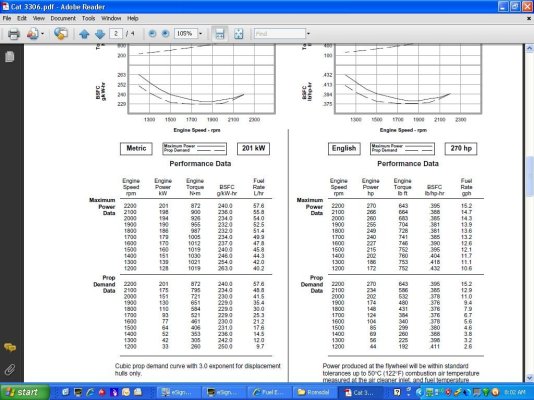Tony B
Guru
- Joined
- Jul 18, 2011
- Messages
- 1,251
- Location
- Cruising/Live-Aboard USA
- Vessel Name
- Serenity
- Vessel Make
- Mainship 36 Dual Cabin -1986
I am not sure if this is the proper forum for this question. If not, just shoot me.

*
I posted this question on a different site and now I will try it here.
*
I am looking at several different trawlers at the moment. The Marine Trader 34 typically has a 120 HP engine with a cruising speed of 6K. A 36' Morgan West Indian has a 160HP engine with a cruising speed of 8K. Being retarded when it comes to motors, I made some simple calculations:
160HP divided but 120 HP = 1.333 larger.
8 Knots divided by 6 Knots = 1.333 Faster.
Looking at the above it would appear that the consumption ratio is the same exact as the Speed/Distance ratio.
Does this mean that if I am burning 1.333 times as much fuel and traveling 1.333 times further I am getting the same MPG from both vessels?
*
I do know that the boat with the longer waterline wil have a higher theoretical hull speed. What I dont understand is that I have had several Marine Trader owners write and pretty much all claim the same speed and fuel consumption all using the same 120HP engine on the 32' - 18000 lbs* up to the 40' @ 30,000 lbs. Surely this cant be so.
*
Anyway, I am in the seriously looking stage and whatever I buy will be a used boat probably around 30 years old. We intend to do the Great Loop and fuel economy will be a big factor. We have pretty much settled in our minds that a 34' to 38' would be good for us depending on cost and scondition.
*
Please educate me on fuel consumption.
*
Thanks in advance
*
Tony B
*
I posted this question on a different site and now I will try it here.
*
I am looking at several different trawlers at the moment. The Marine Trader 34 typically has a 120 HP engine with a cruising speed of 6K. A 36' Morgan West Indian has a 160HP engine with a cruising speed of 8K. Being retarded when it comes to motors, I made some simple calculations:
160HP divided but 120 HP = 1.333 larger.
8 Knots divided by 6 Knots = 1.333 Faster.
Looking at the above it would appear that the consumption ratio is the same exact as the Speed/Distance ratio.
Does this mean that if I am burning 1.333 times as much fuel and traveling 1.333 times further I am getting the same MPG from both vessels?
*
I do know that the boat with the longer waterline wil have a higher theoretical hull speed. What I dont understand is that I have had several Marine Trader owners write and pretty much all claim the same speed and fuel consumption all using the same 120HP engine on the 32' - 18000 lbs* up to the 40' @ 30,000 lbs. Surely this cant be so.
*
Anyway, I am in the seriously looking stage and whatever I buy will be a used boat probably around 30 years old. We intend to do the Great Loop and fuel economy will be a big factor. We have pretty much settled in our minds that a 34' to 38' would be good for us depending on cost and scondition.
*
Please educate me on fuel consumption.
*
Thanks in advance
*
Tony B

